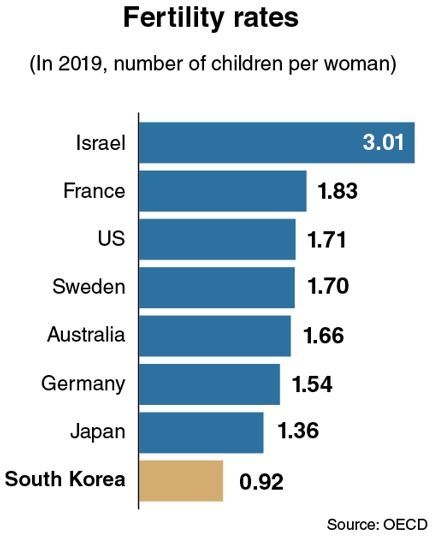[News Focus] Deaths outnumber births in 22 of recent 23 months
Korea’s working age population falls to 25-year low
By Kim Yon-sePublished : Oct. 31, 2021 - 15:21

SEJONG -- The number of deaths outstripped that of births in 22 of the past 23 months in South Korea, which could signal mid and long-term risks in terms of national competitiveness due to a shrinking workforce.
A continuous decline in the working age population, those aged between 15-64, is likely to undermine national competitiveness in the coming years and decades. Of the entire population, the size of the working age population has dipped to the lowest in 25 years at 71.1 percent.
According to the Ministry of Interior and Safety, monthly deaths continued to outnumber births from November 2019 to September 2021, except during September 2020.
This is an unprecedented situation since the nation started compiling the relevant data. Formerly, there were only three months where deaths outnumbered births -- in January 2018, December 2018 and January 2019.

In January 2018, deaths outnumbered births by 31,857 vs. 30,615 in a historic first. This marked the first time, unofficially, that the numbers switched since the mid-1950s or 1960s.
The cumulative death tally in the Nov. 2019-Sept. 2021 period was higher by about 10.5 percent (62,300) than that of births for the 23-month period by 589,048 vs. 526,748.
Interior Ministry data shows the severity of Korea’s demographic crisis: The number of people under 10 (3.8 million) posted less than 50 percent of those in their 40s (8.18 million) and those in their 50s (8.61 million) as of last month.
The tally for the youngest age bracket also stood at less than 60 percent of the number of people in their 60s (7.09 million) or those in their 30s (6.74 million). Further, the number of children aged 0-9 were also comparable to the tally for those aged 70-79 (3.7 million).
Data from the Organization for Economic Cooperation and Development showed Korea has fallen far behind the average of its 38 members and some nonmembers in fertility rates. The country’s fertility rate was already the lowest in the world last year.
In 2019, Korea posted a 0.92 fertility rate -- the total number of children that would be born to each woman if she were to live to the end of her child-bearing years.
Israel topped the list with a fertility rate of 3.01, followed by Mexico at 2.1, Turkey at 1.88, France at 1.83, Colombia at 1.79, Iceland at 1.75, Costa Rica at 1.74 and New Zealand at 1.72.
Among the next in rank were the US at 1.71, the Czech Republic at 1.71, Ireland at 1.7, Denmark at 1.7, Sweden at 1.7, Australia at 1.66, the UK at 1.63, Chile at 1.63 and Slovenia at 1.61.
Japan recorded 1.36, while the OECD average reached 1.61 as of 2019. Among nonmembers, South Africa recorded 2.4, Indonesia with 2.29, Argentina with 2.25, Peru with 2.23, Saudi Arabia with 2.28, India with 2.2, Romania with 1.77, Brazil with 1.72 and China with 1.7.
In 2020 Korea’s fertility rate further declined to stay under the 0.9 mark to post 0.84.
Under such an alarming backdrop, the portion of the working age population fell to 71.1 percent as of last month. This is the lowest in 25 years since it stood at 71 percent in 1996, though this is also due to the sharp growth in seniors -- aged 65 or over -- which reached the all-time high of 16.9 percent of the total population.
The working age population is down by 1 percentage point from 72.1 percent in October 2019, a month before deaths began outnumbering births. The figure was 73.1 percent in September 2016 and 73.3 percent in September 2011.
There is a possibility that the figure will go down below the 70 percent mark as early as 2023, with the declining pace likely accelerating in the next decade.
By Kim Yon-se (kys@heraldcorp.com)


















![[Today’s K-pop] Treasure to publish magazine for debut anniversary](http://res.heraldm.com/phpwas/restmb_idxmake.php?idx=642&simg=/content/image/2024/07/26/20240726050551_0.jpg&u=)